| Ventral lateral nucleus | |
|---|---|
 Thalamic nuclei: MNG = Midline nuclear group AN = Anterior nuclear group MD = Medial dorsal nucleus VNG = Ventral nuclear group VA = Ventral anterior nucleus VL = Ventral lateral nucleus VPL = Ventral posterolateral nucleus VPM = Ventral posteromedial nucleus LNG = Lateral nuclear group PUL = Pulvinar MTh = Metathalamus LG = Lateral geniculate nucleus MG = Medial geniculate nucleus | |
 Thalamic nuclei | |
| Identifiers | |
| NeuroNames | 337 |
| NeuroLex ID | birnlex_1237 |
| Anatomical terms of neuroanatomy | |
The ventral lateral nucleus (VL) is a nucleus in the ventral nuclear group of the thalamus.

